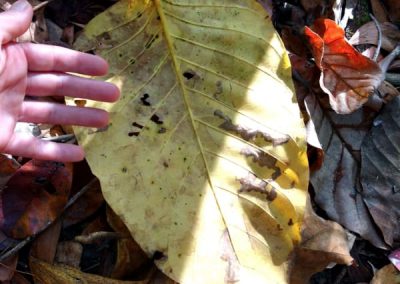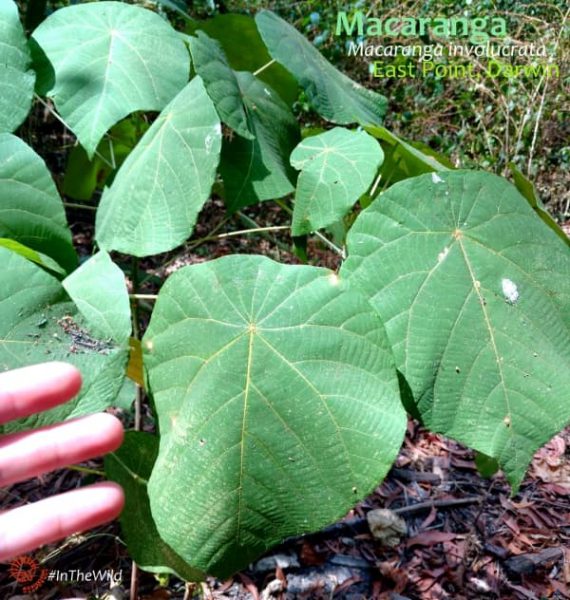The minute we first set foot in the fascinating Top End we felt different. It was everything we loved about Australia – exaggerated.
The Top End is a place of extremes.
Our beloved Aussie eucalyptus trees are there, but they are deciduous. Our savannah woodlands are there, but they are vast, unfragmented and sprinkled with enormous termite towers. Our Aussie billabongs are there, but in the Top End they are deep and clear and full of water lilies. Our gully rainforests are there, but full of palms and figs and trees with leaves as big as your head.
The leaves of the Top End are a destination in themselves. I’ve never seen a place with such fascinating leaves.
What are leaves and what do they do?
For a plant, leaves are the lungs, the skin and the supermarket.
A plant has to breathe (transpire). Like our lungs, the leaves are where most oxygen and carbon dioxide move in and out of the plant. Leaves have pores (stomata) for gas exchange. But stomata lose water as they breathe.
Like our skin, a plant’s leaves are the surface they present to the elements. If the leaves get too wet they attract fungi and mould which stops them making food. If they get too dry they die.
A plant has to grow, so it needs food. Unlike animals, plants produce their own food from sunlight, using the chlorophyll (green pigment) in their leaves. So they don’t need to get food from others – leaves are like an on-board supermarket making food every day.
So a plant needs leaves (or leaf-like structures) to survive.
Why are Top End leaves so fascinating and different?
Top End leaves are fascinating because they have adapted to live in an extreme environment.
In “The Wet” (wet season from November to April), the land can be flooded for miles.
In “The Dry”(dry season from April to October), the land is parched.
All year it is hot.
Top End leaves have developed a range of strategies to survive the extremes, all of which lead to leaves of extraordinary size, shape, colour and pattern.
..
Some leaves are huge.
Examples: Leichhardt Tree Nauclea orientalis, Macaranga involucrata, Native Cherry Exocarpos latifolius, Red Bush Apple Syzygium suborbiculare, Beach Hibiscus Hibiscus tiliaceus.
Large leaves have a lot of surface area to make food, and allow a tree to grow fast in the short growing season. Many of these plants live in monsoon rainforest or close to permanent water. Others lose their leaves in The Dry – see point below.
..
Some leaves are really shiny.
Examples: Red Bush Apple Syzygium suborbiculare, Cathormium umbellatum, Native Cherry Exocarpos latifolius, Banyan Ficus virens.
Shininess comes from the cuticle – a waxy layer on the leaf surface. This slows water loss when dry, allows excess rain to drip off when wet, and reflects sunlight so the leaf doesn’t get too hot.
..
Some leaves are furry.
Examples: Hibiscus leptocladus, Hibiscus panduriformis, Beach Hibiscus Hibiscus tiliaceus, Azanza thespesioides
The furry, felted leaves have a thick layer of hairs that slow air movement across the surface and reduce evaporation. Most of the leaves have white hairs that reflect sunlight.
..
Some leaves are grey, white, blue or red
Examples: Swamp Wattle Acacia dimidiata, Hibiscus leptocladus
This colour can be caused by white hairs on the leaf surface (see point above), a dull waxy coating that appears white, grey or blue, or possibly pigments in the leaf itself. Hairiness and waxiness improve water efficiency, and anthocyanin pigments play a role in protecting leaves against excessive sunlight.
..
Some leaves fall.
Examples: many deciduous eucalypts including Poplar Gum Eucalyptus bigalerita; Red-flowered Kurrajong Brachychiton paradoxus, Northern Kurrajong Brachychiton diversifolius Yellow Kapok Cochlospermum fraseri and Leichhardt Tree Nauclea orientalis
Rather than try to tough out the Dry season, some plants just drop their leaves. Losing leaves means minimal water loss. The stem and roots of the plant just scrape by, not growing, just surviving The Dry season. Then as The Wet approaches they use stored energy to produce leaves and flowers fast.
The flowers on bare branches look super cool.

..
.
Some leaves are not leaves.
Examples: Jacksonia dilatata and others, Acacia pellita and most Acacias
Because leaves lose water, some plants have dispensed with them altogether. Instead, other parts of the plant do the job of manufacturing food. Cladodes are flattened stems, and can be seen on Jacksonia, and others. Cladodes possess chlorophyll so can still function like leaves, but have fewer stomata than leaves, so lose less water. Phyllodes are flattened leaf stalks, and mostly found on Acacia (wattles). Phyllodes perform better under water stress and high sunlight than leaves – and phyllodes survive harsher conditions for longer than leaves.
..
The leaves are not the only fascinating part of the Northern Territory Top End. The wildlife is exaggerated too, reaching huge size or congregating in enormous flocks, displaying a wildly fluorescent colour palette or cloaked in mystery.
Come and see it for yourself. The 6 day Wild Top End tour runs 31 August to 5 September 2019, and dates for August 2020 will be published soon.



































